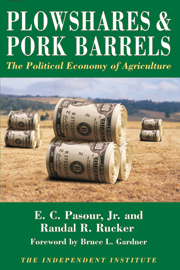Hailed as an environmentally friendly alternative to fossil fuels and a means of reducing U.S. dependence on Middle East oil, the U.S. ethanol program has mutated into a huge tax-financed boondoggle whose costs far outweigh its benefits.
Like so much else that originates in Washington, the program was sold to the public by overstating its benefits and understating its costs. The myriad unintended consequences—political byproducts that range from higher food prices to environmental damage—were ignored altogether.
President Bush’s 2005 energy bill mandated an increase of more than 50 percent over five years in the amount of renewable fuel (mostly corn-based ethanol) added to America’s gasoline supply, increasing from 4.7 billion gallons this year to 7.5 billion gallons in 2012. Although the current mandate represents only a tiny percentage of total annual gas consumption, President Bush has proposed increasing the mandate nearly five-fold over the following five years, pushing it up to 35 billion gallons by 2017. This would comprise about 25 percent of current U.S. annual gasoline consumption. If corn alone were used to produce the ethanol, an increase of this magnitude would require more corn than is currently produced in the United States.
Even this, however, would do little to reduce petroleum imports or the use of petroleum products in the United States. One reason is the huge amount of petroleum used in growing, harvesting, and transporting the corn needed to produce the mandated amount of ethanol.
More fuel consumed
Another is that ethanol has significantly lower energy content than gasoline, as evidenced by Environmental Protection Agency (EPA) vehicle mileage estimates. The EPA estimates that overall, vehicles using gasoline get about one-third more miles per gallon than vehicles using E85 (a fuel comprised of 85 percent ethanol). Thus, a car or truck using E85 will consume about one-third more gallons of fuel than a vehicle using gasoline to drive the same distance.
Another downside is the costs. The subsidies for ethanol include a 51 cent per gallon tax credit, as well as other incentives to corn farmers and small ethanol producers. Combined, these total roughly $1 per gallon. The total subsidy cost this year alone will be about $5 billion. Even with these huge subsidies, however, the fact that federal mandates are required to increase consumption of ethanol suggests that it is still not competitive with gasoline.
Ethanol producers, of course, have a huge stake in the mandate; some 78 ethanol plants are under construction in the United States, with 113 already operating. While agribusiness giant Archer-Daniels-Midland is the largest ethanol producer, many ethanol plants are relatively small and specialized. These owe their very existence to the subsidies.
Corn-belt land owners are another major beneficiary of the program. With corn prices soaring, land values and land rents are up dramatically. Owners of farm land are receiving windfall gains, while growers who rent land see the benefits of higher prices offset by higher rents.
Jolting other crops
Meanwhile, by diverting corn to ethanol production, the mandate is roiling markets for other products. The U.S. Department of Agriculture estimates that the number of acres planted in corn this year will be the largest since 1944. But more corn for ethanol means less corn and less land for other uses, reducing supplies and pushing up prices of soybeans, oats, sorghum, wheat, and barley. It also raises the price of corn used to feed livestock, make breakfast cereal, and sweeten soft drinks. In short, while agricultural landlords and ethanol producers gain, consumers lose.
Another unintended consequence of the ethanol mandate is its environmental impact. More land in corn means increased use of fertilizer and pesticides. It also means more stress on wildlife habitat as more farm land, including idled land and pasture land, is brought back into crop production. And ethanol plants emit pollutants.
Government intervention in one market almost always begets further intervention in other markets. In this instance, subsidies to domestic ethanol markets have been augmented by a 54-cent per gallon tariff on ethanol from Brazil to prevent those imports from undermining the U.S. ethanol industry.
When all is said and done, the ethanol program is just another form of political pork that benefits the few at the expense of the many.










